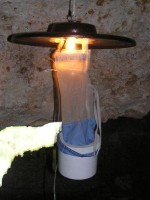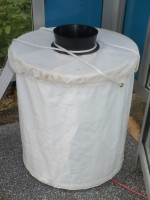Trapping (light traps, ovitraps and other traps)
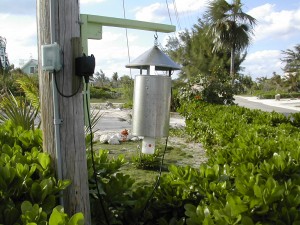
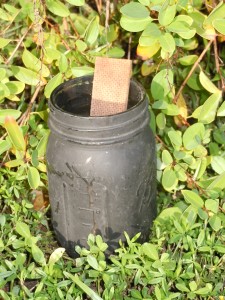 Mosquito numbers are monitored by the MRCU using a network of 31 traps in Grand Cayman and nine in Cayman Brac. The numbers of mosquitoes caught in these traps in different locations aid our scientists in making decisions on where chemicals need to be applied and when. There are a number of different trap types that we use. For example New Jersey Traps (left) these form our routine trap network and can be seen around the island all year round.
Mosquito numbers are monitored by the MRCU using a network of 31 traps in Grand Cayman and nine in Cayman Brac. The numbers of mosquitoes caught in these traps in different locations aid our scientists in making decisions on where chemicals need to be applied and when. There are a number of different trap types that we use. For example New Jersey Traps (left) these form our routine trap network and can be seen around the island all year round.
An Ovitrap (right) is a simple trap for monitoring populations of the dengue mosquito, Aedes aegypti; the mosquito lays its eggs in this trap. CDC light traps (below left), and BG Sentinel Traps (below right) are used for short term monitoring in response to complaints from the public or in projects run by the scientific staff.
Met Data
Each day the MRCU collects data on rainfall from 31 different locations around the island as well as monitoring the daily high tide level.
Survey
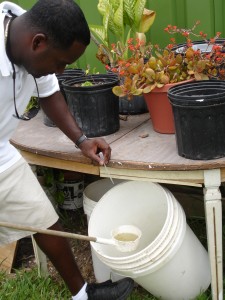 Teams of MRCU staff can often be seen surveying yards around the islands. They are working to identify potential mosquito breeding sites. They tip out sources of standing water if they can and treat remaining containers with insecticides designed to kill mosquitoes at the immature stage (before they are capable of biting). You can help staff by taking charge of your yard, disposing of trash, emptying containers after the rain, changing water in plant pots and animal bowls and unblocking gutters and drains.
Teams of MRCU staff can often be seen surveying yards around the islands. They are working to identify potential mosquito breeding sites. They tip out sources of standing water if they can and treat remaining containers with insecticides designed to kill mosquitoes at the immature stage (before they are capable of biting). You can help staff by taking charge of your yard, disposing of trash, emptying containers after the rain, changing water in plant pots and animal bowls and unblocking gutters and drains.
Residual Treatments
Mosquitoes like to rest on cool places, like the eaves of houses, on walls and in the bushes. Occasionally staff will target these areas to reduce mosquito numbers. The insecticide remains on the surface for a number of weeks killing the mosquitoes as they land.
Fogging
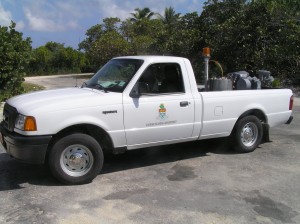 Fogging can be carried out by truck or on foot. This is carried out at times when the target mosquito is most active. Small droplets are used that stay in the air as long as possible and kill the flying mosquitoes on contact. This is just like spraying flies in your house with an aerosol only on a bigger scale.
Fogging can be carried out by truck or on foot. This is carried out at times when the target mosquito is most active. Small droplets are used that stay in the air as long as possible and kill the flying mosquitoes on contact. This is just like spraying flies in your house with an aerosol only on a bigger scale.
.
Hatch and Strand (and the Canals)
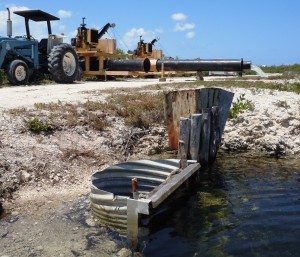 Hatch and Strand is a program set up by MRCU whereby we can manipulate the water levels that allow the swamp to reduce the numbers hatching at the start of the season. During the dry season the swamp mosquitoes lay their eggs just above the water line meaning when the tide significantly increases or rain begins to fall they will flood and hatch in large numbers.
Hatch and Strand is a program set up by MRCU whereby we can manipulate the water levels that allow the swamp to reduce the numbers hatching at the start of the season. During the dry season the swamp mosquitoes lay their eggs just above the water line meaning when the tide significantly increases or rain begins to fall they will flood and hatch in large numbers.
During the spring time low tides we are able to block off large sections of the swamp using a system of sluice gates and water is pumped into these areas in order to flood them. This is maintained for several days to allow the larvae to hatch. Following this the sluice gates are opened and the water drains out to sea taking large numbers of mosquito larvae with it and stranding the rest in the mud to die.
The canals also act as a passive means of control allowing tidal variations into and out of the swamp. They also aid drainage after heavy rainfall.
Aerial Operations
Perhaps our most obvious action against mosquitoes is carried out using our two custom built Turbo Thrush aircraft. They are really useful for helping us to get to otherwise hard to reach places within the central mangrove swamp. We use the aircraft for two main purposes.
Larviciding
These missions are carried out in the daytime; pellets of insecticide are dropped in the swamps and pasturelands to kill mosquito larvae. The first campaign of the year is carried out just before the rainy season starts so that when the rains come and the mosquito eggs hatch the larvicide is waiting for the larvae as they emerge. The pellet formulations are long lasting and break down slowly in the water releasing more chemical as time passes.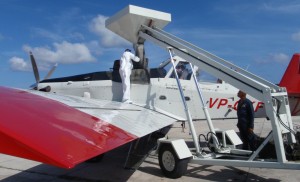
Adulticiding
Our evening missions attack the adult mosquitoes using adulticidal (meaning they target adult mosquitoes) sprays. Similar to the fogging missions the spray equipment releases tiny droplets that stay in the air killing the adults on contact. We fly around sunset as this is the time when the swamp mosquitoes are most active.

